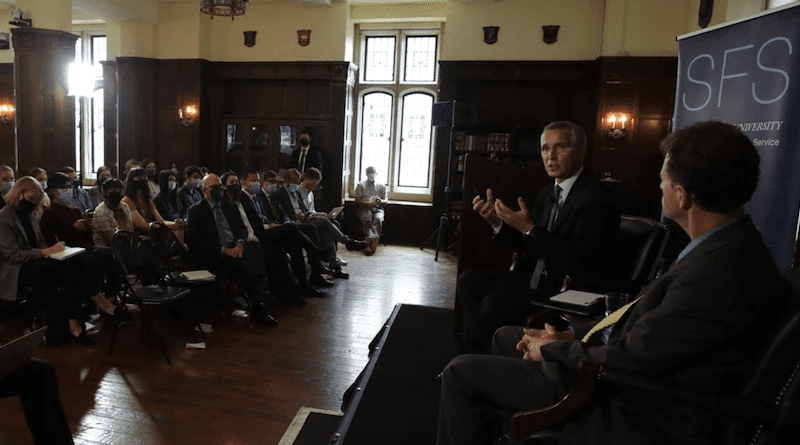New Threats To NATO, Demand Old Solution: Unity, Stoltenberg Says
By DoD News
By Jim Garamone
The world faces uncertainty with threats not only from nation states like China and Russia, but from climate change, cyber attacks as well as new terror groups, and NATO Secretary General Jens Stoltenberg made a compelling case that the only way to face these threats is together.
Stoltenberg, who spoke at a joint Brookings Institution/Georgetown University event in Washington, emphasized that these new threats demand an old solution: Unity.
The trans-Atlantic relationship may be the most important to world peace. The North Atlantic Alliance has kept the peace in Europe since the end of World War II. It faced down and deterred the Soviet Union over the course of generations. NATO is arguably the most successful; alliance in history, he said.
Still, new factors could end the alliance. Even after the successful NATO Summit in June, there were questions about the strength of the bond between Europe. Since then, many wonder what the Australia-United Kingdom-United States pact will mean. Others wonder what the withdrawal from Afghanistan means. Still others wonder if Europe should go it alone.
“We must always take our differences seriously and address them,” Stoltenberg said. “But they do not change the big picture: the importance of Europe and North America, standing together in NATO. In fact, the need for trans-Atlantic unity is greater today than at any time since the end of the Cold War. Because we are at a pivotal moment for our shared security, where we face a more dangerous and more competitive world.”
Russia is more aggressive abroad and more oppressive at home, the secretary general said. China is using its economic and military might to control its own people, coerce other countries and assert control over global supply chains, critical infrastructure and other assets.
Cyber attacks, persistent terror threats and security fallout from climate change do not recognize borders. “None of us can face these challenges alone, no country, however big, and no continent, however rich. Neither the U.S. nor Europe can face these alone,” he said. “But in NATO, we are not alone.”
NATO is 30 nations with a billion people. The alliance has half of the world’s economic and military might. And the alliance works with like-minded partners, which increases its reach and effectiveness.
“Together we are adapting to a more uncertain world,” he said. “In fact, our alliance is in the midst of a fundamental shift. This started in 2014 in response to Russia’s illegal annexation of Crimea.”
The alliance is shifting efforts and resources from large combat operations outside NATO to strengthen deterrence and defense at home and prepare for a world of greater state-to-state rivalry, he said. “All allies have increased defense spending, invested in high-end capabilities and boosted the readiness of our forces,” the secretary general said. “We have increased our presence on land, at sea and in the air and deployed multinational combat units in the eastern part of the alliance in the Baltic region, and strengthened our defenses against cyber and hybrid attacks.”
But the alliance cannot remain static and leaders agreed in June to modernize the force and strategy and chart the course of the alliance over the next decades. “As we continue to boost our military readiness to respond to threats from any direction, we’re also sharpening our technological edge by launching a new defense innovation accelerator and innovation fund to support industry, startups and academics working on cutting edge technologies,” Stoltenberg said. “We are strengthening our cyber defenses and increasing resilience within our critical infrastructure and supply chains to reduce our vulnerabilities. We are stepping up to defend the rules-based international order by deepening our cooperation with like-minded countries and organizations, including in the Asia Pacific.”
One sharp change is the emphasis on the security effects climate change will have on the world. “For the first time in our history, we are putting climate change and security at the core of NATO’s agenda,” he said. “Climate change fuels and multiplies the risk of conflict and threatens our security and impacts the environment in which we operate. So NATO must play its part. We are adapting our planning installations and equipment to more extreme weather, and establishing the first ever methodology to map military missions across the alliance, so that also we can contribute to the goal of net zero emissions.”
All this will increase deterrence and make for a more robust defense.
“We do not know what the next crisis will be,” he said. “But we do know that whatever happens, we are safer when we stand together, Europe and North America, strong in NATO for more than 70 years. We must continue to stand strong together to face a more competitive world. That is good for Europe, and it’s good for North America.”

